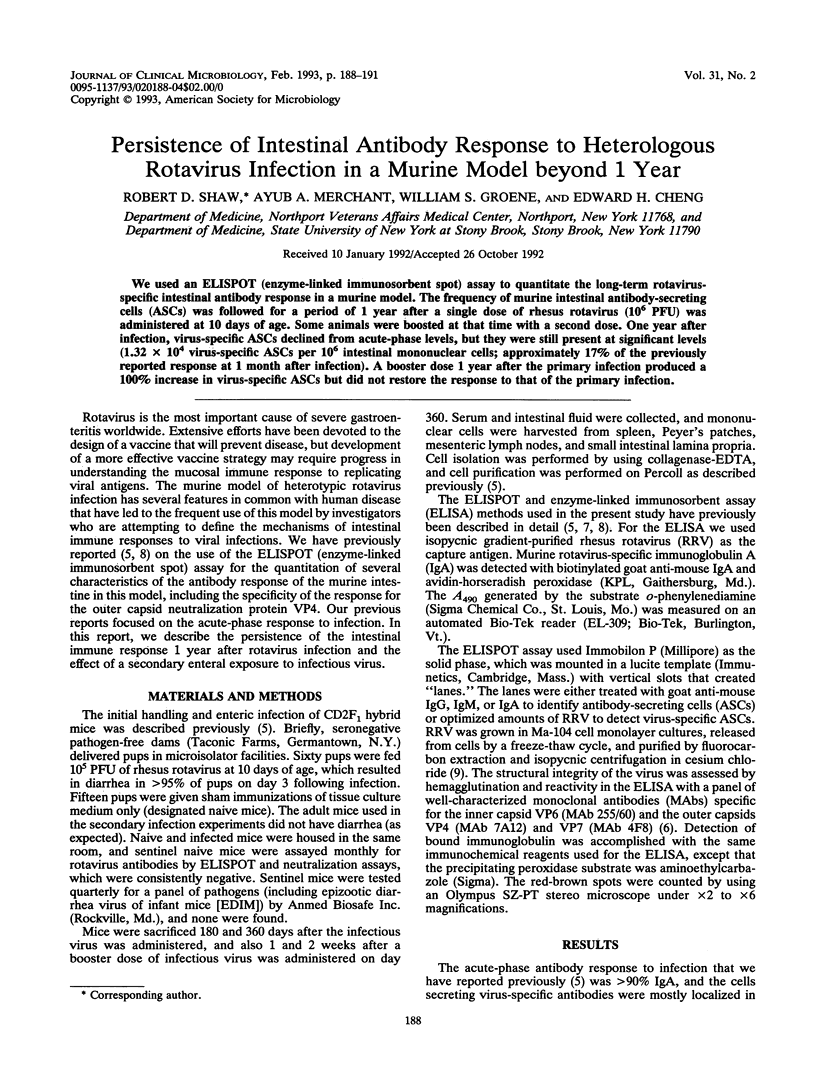Abstract
We used an ELISPOT (enzyme-linked immunosorbent spot) assay to quantitate the long-term rotavirus-specific intestinal antibody response in a murine model. The frequency of murine intestinal antibody-secreting cells (ASCs) was followed for a period of 1 year after a single dose of rhesus rotavirus (10(6) PFU) was administered at 10 days of age. Some animals were boosted at that time with a second dose. One year after infection, virus-specific ASCs declined from acute-phase levels, but they were still present at significant levels (1.32 x 10(4) virus-specific ASCs per 10(6) intestinal mononuclear cells; approximately 17% of the previously reported response at 1 month after infection). A booster dose 1 year after the primary infection produced a 100% increase in virus-specific ASCs but did not restore the response to that of the primary infection.
Full text
PDF



Selected References
These references are in PubMed. This may not be the complete list of references from this article.
- Berek C., Milstein C. Mutation drift and repertoire shift in the maturation of the immune response. Immunol Rev. 1987 Apr;96:23–41. doi: 10.1111/j.1600-065x.1987.tb00507.x. [DOI] [PubMed] [Google Scholar]
- Dharakul T., Riepenhoff-Talty M., Albini B., Ogra P. L. Distribution of rotavirus antigen in intestinal lymphoid tissues: potential role in development of the mucosal immune response to rotavirus. Clin Exp Immunol. 1988 Oct;74(1):14–19. [PMC free article] [PubMed] [Google Scholar]
- Kavaler J., Caton A. J., Staudt L. M., Gerhard W. A B cell population that dominates the primary response to influenza virus hemagglutinin does not participate in the memory response. Eur J Immunol. 1991 Nov;21(11):2687–2695. doi: 10.1002/eji.1830211107. [DOI] [PubMed] [Google Scholar]
- Lycke N., Holmgren J. Long-term cholera antitoxin memory in the gut can be triggered to antibody formation associated with protection within hours of an oral challenge immunization. Scand J Immunol. 1987 Apr;25(4):407–412. doi: 10.1111/j.1365-3083.1987.tb02207.x. [DOI] [PubMed] [Google Scholar]
- Merchant A. A., Groene W. S., Cheng E. H., Shaw R. D. Murine intestinal antibody response to heterologous rotavirus infection. J Clin Microbiol. 1991 Aug;29(8):1693–1701. doi: 10.1128/jcm.29.8.1693-1701.1991. [DOI] [PMC free article] [PubMed] [Google Scholar]
- Shaw R. D., Groene W. S., Mackow E. R., Merchant A. A., Cheng E. H. VP4-specific intestinal antibody response to rotavirus in a murine model of heterotypic infection. J Virol. 1991 Jun;65(6):3052–3059. doi: 10.1128/jvi.65.6.3052-3059.1991. [DOI] [PMC free article] [PubMed] [Google Scholar]
- Shaw R. D., Stoner-Ma D. L., Estes M. K., Greenberg H. B. Specific enzyme-linked immunoassay for rotavirus serotypes 1 and 3. J Clin Microbiol. 1985 Aug;22(2):286–291. doi: 10.1128/jcm.22.2.286-291.1985. [DOI] [PMC free article] [PubMed] [Google Scholar]
- Shaw R. D., Vo P. T., Offit P. A., Coulson B. S., Greenberg H. B. Antigenic mapping of the surface proteins of rhesus rotavirus. Virology. 1986 Dec;155(2):434–451. doi: 10.1016/0042-6822(86)90205-9. [DOI] [PubMed] [Google Scholar]
- Siekevitz M., Kocks C., Rajewsky K., Dildrop R. Analysis of somatic mutation and class switching in naive and memory B cells generating adoptive primary and secondary responses. Cell. 1987 Mar 13;48(5):757–770. doi: 10.1016/0092-8674(87)90073-0. [DOI] [PubMed] [Google Scholar]
- Stenzel-Poore M. P., Bruderer U., Rittenberg M. B. The adaptive potential of the memory response: clonal recruitment and epitope recognition. Immunol Rev. 1988 Oct;105:113–136. doi: 10.1111/j.1600-065x.1988.tb00769.x. [DOI] [PubMed] [Google Scholar]


